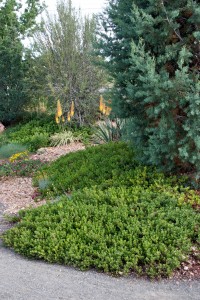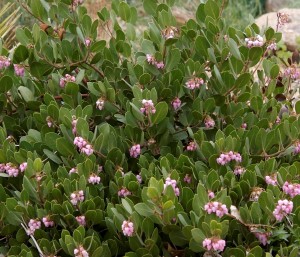Hardy manzanitas: Welcome winter beauty
Arctostaphylos x coloradensis
Western winter gardens are made all the more lovely with evergreens — whether the gardens are filled with conifers such as pines, spruce and junipers, or graced with broad-leaved evergreens. In the deep of winter, the colors of summer and fall have faded into our memories, and our yearning for spring has already begun.
But choices of broad-leaved evergreens for western gardeners consist primarily of plants that are native to regions of the world with more moisture, soils higher in organic matter and climates with fewer weather extremes.
Shrubs native to North America
It has only been in recent years that plants from North America are becoming readily available in local nurseries and garden centers. One of the most well-known is kinnickinnick (Arctostaphylos uva-ursi), a broad-leaved evergreen groundcover, used regionally for many years. Amazingly, kinnickinnick is actually native to more than half of the United States (except for the Southeast and central states) and every province in Canada. An extremely hardy and adaptable species, it’s primarily been the clones from the two coasts (‘Point Reyes’, ‘Woods Compact’ and ‘Massachusetts’). that have been grown commercially all these years, not selections from our western states.
Some local and regional growers are collecting local seed and providing western native selections of kinnickinnick, but only recently have our western native, larger cousins to kinnickinnick — the manzanitas — become more commercially available.
Hardy manzanitas by Plant Select®
The first were introduced by Plant Select® in 2005 (Mock Bearberry) and 2006 (Panchito) – two selections of natural hybrids from the Uncompaghre Plateau in western Colorado. The largest and most vigorous of the group, Chieftain, was introduced in 2013.
All three are adapted to our dry climate, mineral soils, fluctuating temperatures and high altitude winter sunshine, making them perfect choices for winter color and interest for our region.
The beauty of these slightly larger Arctostaphylos lies beyond the green relief of their leaves in winter gardens, it also comes from the strong, undulating branches and their deep red-mahogany colored bark. And in late winter and early spring – petite, pink flowers hang in small clusters from the branches, lasting for nearly six weeks, or until temperatures begin to rise in earnest. Mature plants will often produce dark red, tiny apple-like berries in summer.
Wildlife benefits
The primary benefits of the medium-sized Arctostaphylos (A. x coloradoensis) for wildlife lies in the year-round cover provided by the evergreen leaves. Undulating branches allow for shelter of smaller songbirds and mammals, and leaf litter beneath often is home to many insects, supplying a decent food source during much of the year.
The groundcover kinnickinnick (A. uva-ursi) is a much more prodigious fruit-producer, and the edible “berries” are regularly eaten by bears, small mammals and fruit-eating songbirds.
 This post is part of the Be a Habitat Hero project, a partnership of Audubon Rockies, High Country Gardens and Plant Select®.
This post is part of the Be a Habitat Hero project, a partnership of Audubon Rockies, High Country Gardens and Plant Select®.




Do you have a list of edible plants that qualify as wildscapes and habitat hero for Arvada, CO? Thanks
You might try Audubon – we don’t have a lot of edibles in the Plant Select program. http://rockies.audubon.org/conservation/habitat-hero-education
Is Panchito manzanita deer resistant? I only see the designation in the Plant Select guide and not in nursery lists.
It is, along with all the coloradoensis hybrids. All are rarely browsed in the wild.
Deer just chomped two plants I just put in the ground.
Darn! I don’t know what to say except I’d like to see photos. Email them to Director@PlantSelect.org
The deer prune my 20-year-old arctostaphylos nevadensis pretty regularly, it’s gotten fairly big but would be even larger without the periodic chomping.
I started Arctostaphylos two years ago and found the deer like to clip the new spring growth. I have since covered with a small wire cage to prevent the deer from browsing. Next year, it looks to be large enough to remove the wire cage.
[…] http://plantselect.org/plantstories/colorados-hardy-manzanitas-welcome-winter-beauty/ […]
Where can I source Panchito Manzanita? Would love to purchase some.
If you are in CO, most retailers and wholesalers will carry them. Holden Wholesale Growers in Oregon (503-873-5940) is the largest grower of Panchito Manzanitas and can tell you what locations near you they ship to. Visit this link for phones numbers and websites all over the country. https://plantselect.org/where-to-buy/retailers/
I read that a recommendation is to add expanded shale or squeegee to provide more drainage for the manzanitas. We have heavy clay soil in many areas of our yard. Will that work? If so, what are the proportions of the amendment to soil? Also where do you buy these amendments?
Yes, that will work and you should make a mix of at least 50/50 squeegee to your current soil. A five-gallon bucket of it ought to work and that can be purchased at any landscape supply yard. Interestingly enough I have seen these manzanitas grow spectacularly in 4″ of wood mulch. I’m still trying to figure that out.
What is “squeegee“ discussed above?
It’s like pea gravel with smaller rocks in it. Landscape supply such as Pioneer sell it in bulk.
Regarding the 5- gallon bucket of squeegee for planting manzanitas. Is that 5 gallons per plant?
No, it should go by hole size. If you’re not removing any soil, just adding squeegee, 1 part squeegee to 2 parts topsoil will work without leaving a large bump in the garden.
Do Hardy Manzanita respond well to pruning?
They respond well to light pruning, but they won’t flush out again right away if that is what you are hoping. These plants are proving to be more and more resilient to pruning and transplanting though.
My new manzanitas were planted in late fall. The branches seemed very brittle and broke off easily. I thought they were dormant but since they look they and dry I wonder if they were dead
They may be dead, but give them a little more time. Could be the soil and/or too much moisture. They like well-drained soils.
When is the best time to plant manzanita?
Thanks!
April-June seems to work best for me.
I have 3 Panchito manzanitas that were planted 10 years ago and are outgrowing the area they are located. I trimmed a few branches a couple years ago, but it took a while for those spots to fill in. I’m debating whether to remove them and replace with new manzanitas or do a radical prune. I’m afraid that if I prune, they won’t look very nice until next year. Any thoughts/suggestions?
Keep pruning these. I have actually seen them sheared on properties. They don’t like hard pruning but can handle tip pruning up to about 6-10 inches. You can clean out any dead branches to allow more air and light to lower spots in the plant. Let us know how it goes!
If I plant a Panchito manzanita on a slope, will it tend to grow by ‘spilling downhill’ or should I expect it to spread to its 60 inch maximum more-or-less equally from the center of the plant?
On a slope, it will grow off-center down the slope and not equally up the hill. You’ll have to plan for that, but your sizing is correct for that one side.
We planted a Panchito Manzanita last year (early to mid-summer I think). And over the winter some of the leaves turned yellow, which I’m assuming means they are dead. Should I prune those branches? There are some green leaves, but I fear most of them are being shaded too much by the dead leaves. Also wondering if we may have done something wrong to cause the die-back? It receives morning and afternoon sun, but is shaded in late afternoon. The nearby lead plant is doing fine, as is a bigtooth maple a bit further away. All were getting established last year, and so were watered 2-3 times/week during summer/fall depending on heat and precipitation. We did not water over the winter, but did receive more precipitation than usual. We also had several weeks of colder than usual temperatures. We live in northern Colorado and have clay soil.
It may not be completely dead. Look for suckers sprouting out and if it’s not leafing out on said branches this month then trim them out. It was a tough winter.
Can either Panchito or Mock Bearberry be transplanted?
Very hard to do successfully. Best to purchase others.
Where can I purchase panchito near Denver?
https://plantselect.org/where-to-buy/retailers/
Are these manzanitas tolerant of high soil salinity?
No not really.